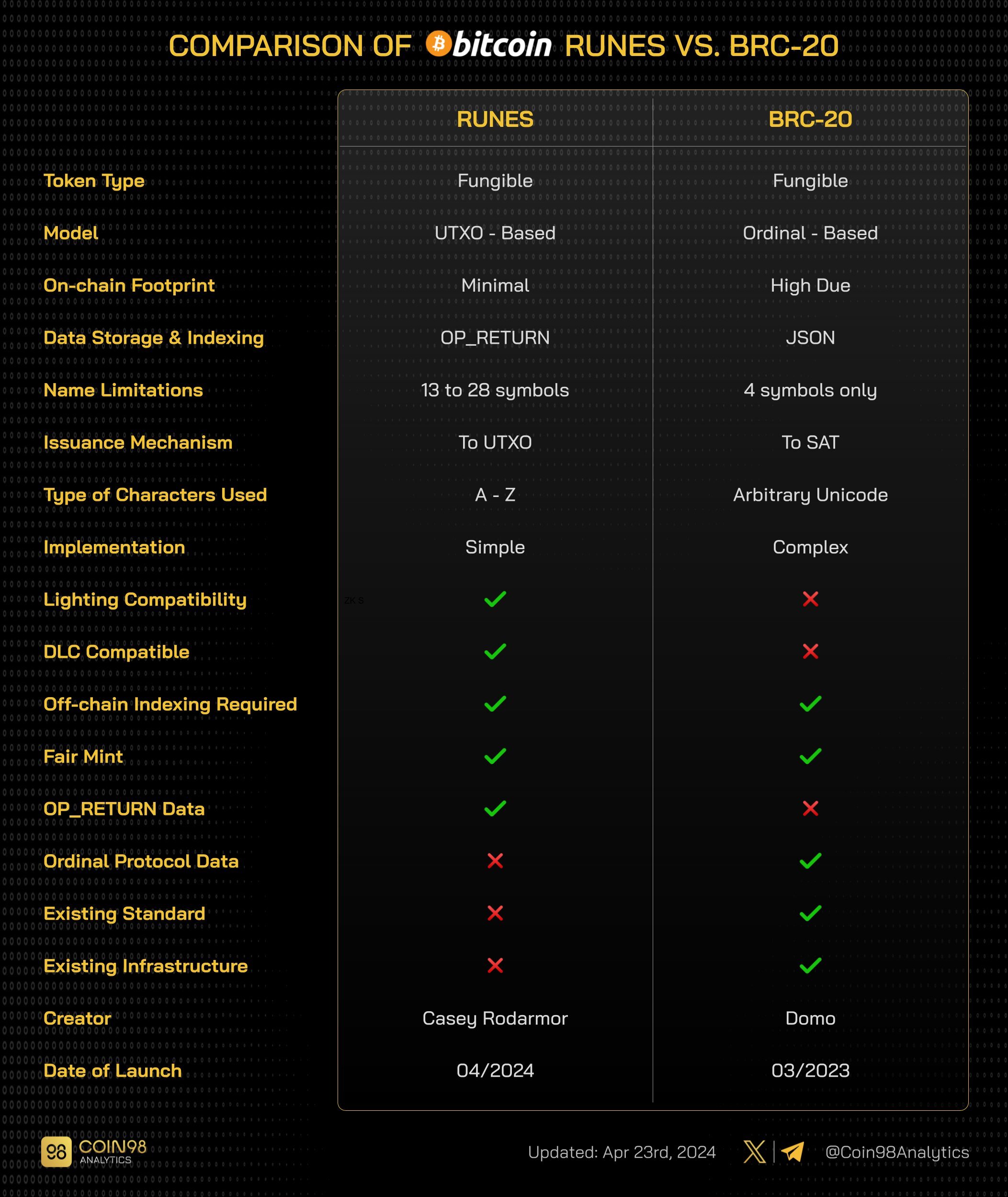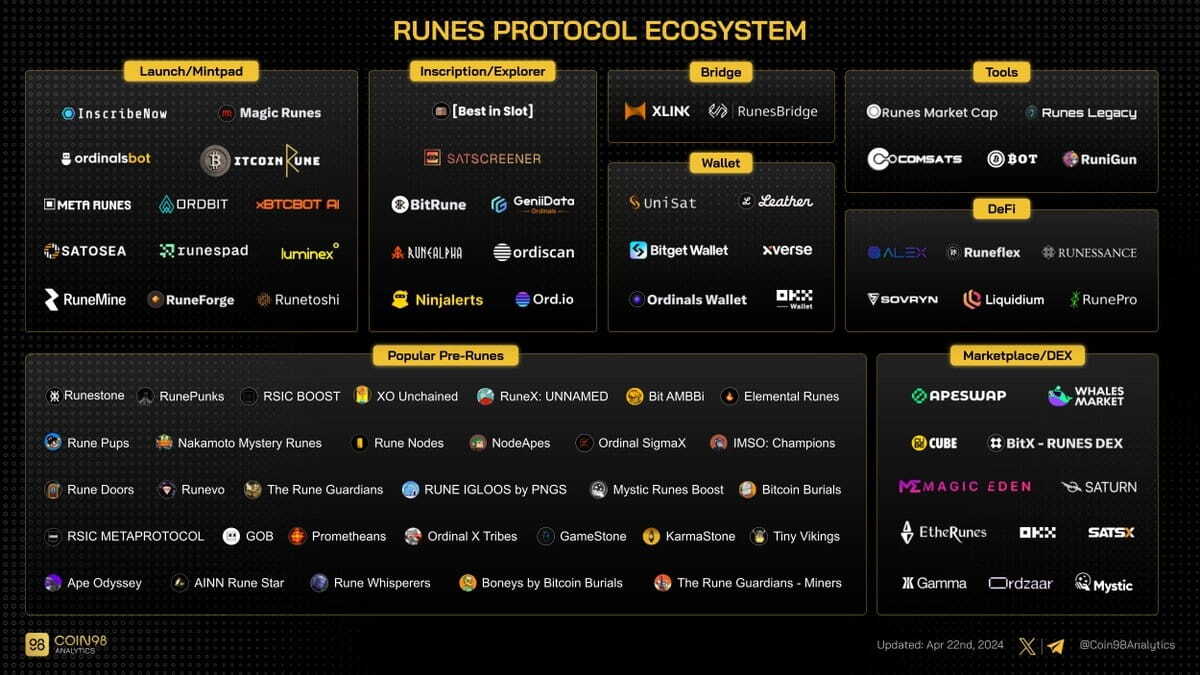Bitcoin Runes Explained

This blog post will cover:
- Technology Сlarified
- Key Features
- Runes compared to BRC-20
- Application in Bitcoin Network
- Conclusion
Runes became a hot topic right after its start in April 2024 following the 4th BTC halving. Runes presented a fresh token standard to establish fungible assets on the BTC blockchain that is more effective and user-friendly compared to previous standards like BRC-20. Shortly after the introduction, Runes grabbed significant attention from the community with the leading Rune project reaching a $2.37B market cap at the moment.
BTC Runes were firstly announced in September 2023 by a popular developer Casey Rodarmor and officially launched on April 20, 2024. Rodarmor, known for the development of Ordinals technology, attempted to facilitate the process of using BTC for creating crypto coins. He assumes that establishing a robust fungible token protocol for Bitcoin will attract substantial transaction fee revenue, grab dev’s attention, and expand the userbase of BTC. Runes were conceived as a solution to this challenge, offering an efficient method for leveraging Bitcoin technology to build and manage assets on the blockchain.
Technology Сlarified
Runes are tokens made on the BTC blockchain using its UTXO transaction model and OP-RETURN function:
UTXO is a quantity of BTC that the user hasn’t spent and has an opportunity to use to make new transactions. It is an output of the previous transaction and may be used as an input for the next.
OP-RETURN allows adding extra info to BTC transactions without damaging blockchain’s efficiency. Users can enhance the transaction up to 80 bytes, for example token name, symbol and commands for specific actions, such as minting. Runes protocol message stored in Bitcoin transaction output is called Runestone.
Runes are made through the Etching process, during which the creator defines parameters such as the ID, name, supply, generation and distribution mechanisms of the Runes using the OP-RETURN. Additionally, Runes can be configured with human-readable symbols and decimal configurations. Once Etching is complete, Runes can be minted via either open or closed mints. Transfer of Runes is facilitated by the Edict function, which outlines the protocol for transferring minted Runes. In case of errors in protocol messages, Runes are being burned.
Key Features
Simplicity. Bitcoin Runes offer a straight method for establishing and managing tokens on the Bitcoin blockchain without leading to any disruption to the network's operation. Furthermore, the creation of Runes doesn’t require the use of native tokens.
Efficiency. Runes prevent the BTC blockchain from being overloaded with extraneous data by leveraging the OP-RETURN function, which permits the addition of only 80 bytes of additional data. Furthermore, the design of Runes prevents the creation of unspent UNXOs, thereby averting network congestion.
UTXO-based Model: Runes seamlessly integrate into the Bitcoin UTXO model, enhancing its efficiency and contributing value to the Bitcoin network.
Runes compared to BRC-20
Unlike the BRC-20 token standard for Bitcoin, which relies on Ordinals technology that causes network congestion through numerous "junk" UTXOs, Runes are native to the Bitcoin UTXO model, demanding fewer resources for their creation. This fact enhances their economic efficiency while reducing Runes on-chain impact on the Bitcoin network. Compared to BRC-20 Runes improve Bitcoin network scalability and sustainability granting a more simple way of creating assets in BTC blockchain. Finally, Runes are more flexible and simple with up to 28 symbols available in name and different mint mechanisms, including closed and open mints.

Source: Coin98 Analytics
Application in Bitcoin Network
Runes drew the attention of the community as a novel method of developing and storing fungible assets on the Bitcoin blockchain. First of all, it is meme tokens that attract new users to the Bitcoin network. With the development of new projects building with Runes technology, the userbase will increase that brings Bitcoin usage on the new highs with potential to create not just memes but also stablecoins, governance and security tokens. Active usage of the network generates more revenue and fosters miners to join Bitcoin blockchain. However, the drawback of it may be high transaction fees. For example, on April 20, following BTC halving and Runes launch, average transaction fee on Bitcoin surged to $127.Overall, Runes can contribute to a more active use of the Bitcoin network for issuing and managing digital assets, unlocking a potential for the 1st blockchain to become a new hub for DeFi activity, compatible with the leading chains in this field, such as Ethereum and Solana.

Source: Coin98 Analytics
Conclusion
Bitcoin Runes, introduced in September 2023 and released in April 2024 present a more effective and easy way to make digital assets, first of all fungible tokens, on the Bitcoin network. Runes technology does not affect the efficiency of the network and uses the Bitcoin UTXO model for creation and managing assets. The 1st use case of Runes is creation of meme tokens on the Bitcoin blockchain, however this technology has all chances to deliver more utility and value to the 1st blockchain.
SimpleSwap reminds you that this article is provided for informational purposes only and does not provide investment advice. All purchases and cryptocurrency investments are your own responsibility.

